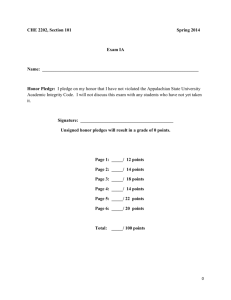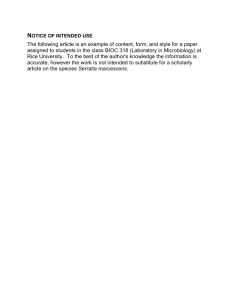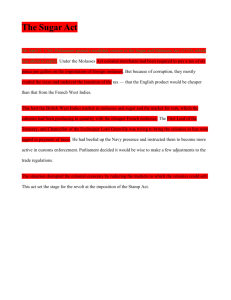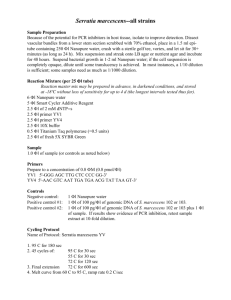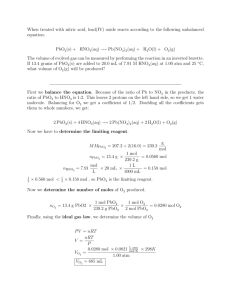noid-Paper2_Optimization_of_β
advertisement
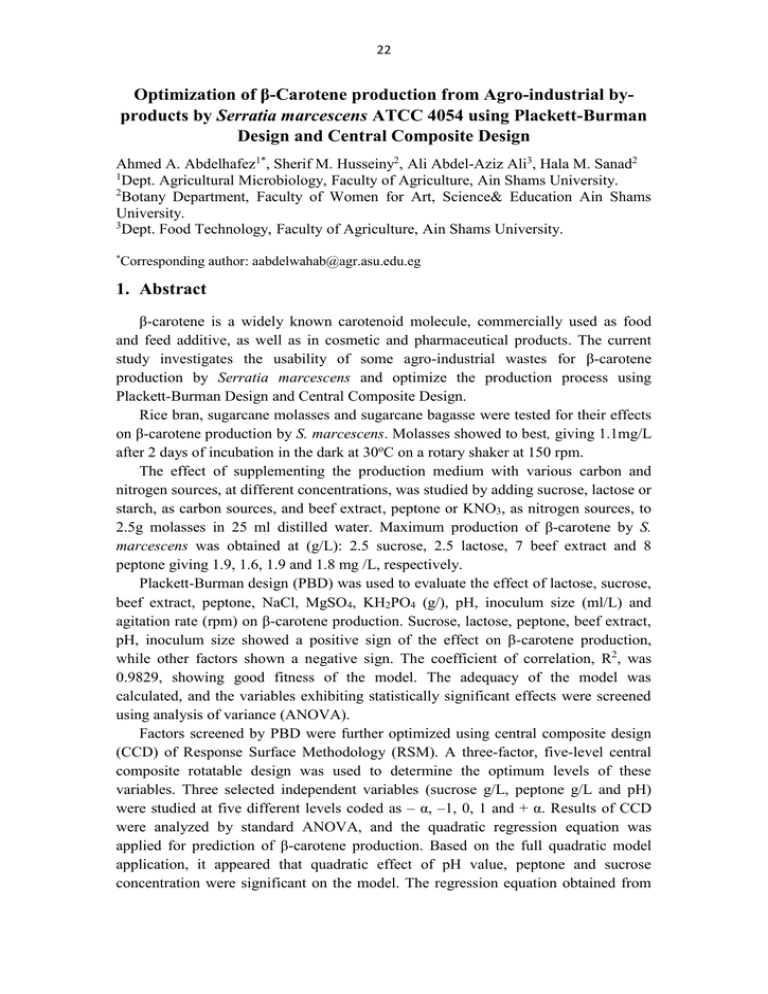
22 Optimization of β-Carotene production from Agro-industrial byproducts by Serratia marcescens ATCC 4054 using Plackett-Burman Design and Central Composite Design Ahmed A. Abdelhafez1*, Sherif M. Husseiny2, Ali Abdel-Aziz Ali3, Hala M. Sanad2 1 Dept. Agricultural Microbiology, Faculty of Agriculture, Ain Shams University. 2 Botany Department, Faculty of Women for Art, Science& Education Ain Shams University. 3 Dept. Food Technology, Faculty of Agriculture, Ain Shams University. * Corresponding author: aabdelwahab@agr.asu.edu.eg 1. Abstract β-carotene is a widely known carotenoid molecule, commercially used as food and feed additive, as well as in cosmetic and pharmaceutical products. The current study investigates the usability of some agro-industrial wastes for β-carotene production by Serratia marcescens and optimize the production process using Plackett-Burman Design and Central Composite Design. Rice bran, sugarcane molasses and sugarcane bagasse were tested for their effects on β-carotene production by S. marcescens. Molasses showed to best, giving 1.1mg/L after 2 days of incubation in the dark at 30oC on a rotary shaker at 150 rpm. The effect of supplementing the production medium with various carbon and nitrogen sources, at different concentrations, was studied by adding sucrose, lactose or starch, as carbon sources, and beef extract, peptone or KNO3, as nitrogen sources, to 2.5g molasses in 25 ml distilled water. Maximum production of β-carotene by S. marcescens was obtained at (g/L): 2.5 sucrose, 2.5 lactose, 7 beef extract and 8 peptone giving 1.9, 1.6, 1.9 and 1.8 mg /L, respectively. Plackett-Burman design (PBD) was used to evaluate the effect of lactose, sucrose, beef extract, peptone, NaCl, MgSO4, KH2PO4 (g/), pH, inoculum size (ml/L) and agitation rate (rpm) on β-carotene production. Sucrose, lactose, peptone, beef extract, pH, inoculum size showed a positive sign of the effect on β-carotene production, while other factors shown a negative sign. The coefficient of correlation, R2, was 0.9829, showing good fitness of the model. The adequacy of the model was calculated, and the variables exhibiting statistically significant effects were screened using analysis of variance (ANOVA). Factors screened by PBD were further optimized using central composite design (CCD) of Response Surface Methodology (RSM). A three-factor, five-level central composite rotatable design was used to determine the optimum levels of these variables. Three selected independent variables (sucrose g/L, peptone g/L and pH) were studied at five different levels coded as – α, –1, 0, 1 and + α. Results of CCD were analyzed by standard ANOVA, and the quadratic regression equation was applied for prediction of β-carotene production. Based on the full quadratic model application, it appeared that quadratic effect of pH value, peptone and sucrose concentration were significant on the model. The regression equation obtained from 23 ANOVA with the R2 value (multiple correlation coefficients) of 0.9210 revealed that the model is fit. The Model F-value of 11.66 implies the model is significant. Finally, the optimum conditions were 2.5 g/L sucrose, 7.8 g/L peptone and pH 6.7 with a maximum predicted β-carotene production of 2.51 mg/L molasses and actual 2.24 mg/L. Keywords: β-Carotene production, Optimization, Agro-industrial by-products, Serratia marcescens, Plackett- B design, Central Composite Design 2. Introduction In contract to natural pigments, addition of synthetic colorants in food products has safety concerns due to its potentially harmful effects on human health (Velmurugan et al. 2010). On the other hand, naturally produced pigments have been shown as important alternative to synthetic food colorants. β-carotene, a member of the carotenoids, is a strongly colored red-orange pigment abundant in plants and fruits. It is biosynthesized from geranylgeranyl pyrophosphate. β-carotene can be obtained by extraction from vegetables, by chemical synthesis or microbial production using certain microorganisms. Microbial production of carotene has some advantages due to their natural characteristics, safe use, medicinal properties and production independent of season and geographical conditions (Rashid and Mazumdar 2014). Moreover, microbial production (by algae, fungi and bacteria) of -carotene has an economic advantage of using low cost natural substrates used as sources of carbohydrates in microbial processes (HernandezAlmanza et al, 2014). Microbial producers of β-carotene include Blakeslea trispora (fungi), Rhodotorula spp., and Saccharomyces cerevisiae (yeast), Dunaliella bardawil (microalgae), and bacteria such as Serratia marcescens (Wang et al., 2012). Several studies showed feasibility for production of carotenoids from low cost substrates, such as rice bran, sugarcane bagasse and corn starch hydrolyzate (Hernandez-Almanza et al., 2014). Therefore, it is necessary to determine the best culture medium and environmental conditions for microbial fermentation in order to exploit the potential of the selected strain. In general, natural pigments has an annual growth rate of 5-10%, comprising 31% of the worldwide colorant market, compared to 40% for synthetic colorants (Downham and Collins, 2000; Mapari et al. 2010). Global production of -carotene reached $ 233 million dollars in 2010, and is expected to reach $ 309million by 2018 with an annual growth rate of 3.6% (Mata-Gómez et al. 2014). 24 Therefore, the aim of the current study was set on utilizing cheap agro-industrial byproducts as basic materials for production of β-carotene by S. marcescens, screening the significant factors affecting β-carotene production process by applying PlacketBurman design then optimizing the levels of these factors by statistical approach of response surface methodology. 3. Materials and Methods 3.1. Microorganism: Serratia marcescens ATCC 27117 was obtained from Cairo Microbiological Resources Center (Cairo MIRCEN), Faculty of Agriculture, Ain Shams University, Cairo, Egypt. S. marcescens was maintained and sub-cultured on nutrient agar slants at 4oC until further use. 3.2. Media used: Nutrient broth media composed of (g/L): beef extract (3), peptone (5) and for nutrient agar (NA), 20g/L were added to the previous composition. Medium pH was adjusted to 7. Nutrient agar medium was used to maintain S. marcescens and for β-carotene production (Wang et al. 2012). The pH was adjusted by 1N NaOH or HCl solution and autoclaved at 121oC for 20 minutes. 3.3. Agro-industrial by-products: Rice bran, sugar cane molasses and sugar cane bagasse were used for β-carotene production. Rice bran was collected from rice farms in El-Beheira governorate (located in the Nile Delta, north of Cairo). Rice bran was dried at 70oC for 2 h, cooled and stored in a desiccator for further studies. Sugar cane molasses was obtained from EL-Howamdia Company, Egypt. Sugarcane bagasse was procured from local sugarcane juice vendor. The bagasse was packed in a cloth carrying bag to prevent the entry of flies and other insects and dried in shade. After drying, the pith portion of the bagasse was extracted manually and the outer rind was discarded. The pith was ground to fine powder in a steel kitchen grinder to reach a particle size of 0.2 – 2 mm. 3.4. Chemical analysis of Agro-industrial by-products: All agro-industrial wastes were analyzed for N, C, P, protein, ash, fiber, moisture, cellulose, hemicellulose at Arid land Agricultural Research and Services Center, Faculty of Agriculture, Ain Shams University. Cellulose and hemicelluloses contents of agro-industrial wastes were determined using the standard laboratory analytical procedures for biomass analysis provided by the National Renewable Energy Laboratory (NREL, USA) and methods developed by the Association of Official ° Analytical Chemistry (A.O.A.C. 1995). Three samples were dried at 105 C to constant weight to determine the biomass moisture content. The ash determination 25 ° was done by burning the samples at 550 C in a muffle furnace (Blue M Electric Company, Blue Island, USA) for 3 h, according to the laboratory analytical procedure for determination of ash. Total nitrogen of wastes was determined using the Kjeldahl method (Bradstreet, 1965). Crude protein content was calculated by multiplying total nitrogen percentage by 6.25 and crude fiber was determined by enzymatic-gravimetric method (A.O.A.C. 1995). Organic carbon is measured using a carbonaceous analyzer, which converts organic carbon to carbon dioxide (CO2) by either catalytic combustion or wet chemical oxidation. Determination of phosphorus was carried out by semiautomated colorimetric method. 3.5. Standard inoculum: One loop of a 24-h-old slant cultures grown on NA was mixed with 100 ml of saline solution (0.9%) in 250-ml Erlenmeyer flasks to prepare microbial suspension with 108 cfu/ml using optical density at 550 nm for all experiment. 3.6. β-carotene production by Serratia marcescens ATCC 27117 For production of b-carotene, all tested wastes were used as the basal production medium giving a final carbon concentration of 1%, therefore, 5.5 g of rice bran in 7 ml distilled water, 2.5 g molasses in 25 ml distilled water and 7.1 g bagasse in 18 ml distilled water were placed in 250-ml Erlenmeyer flasks. After sterilization, 5 ml of microbial suspension were transferred to each of the flasks and these were compared to a treatment containing nutrient broth medium. Flasks were incubated at 30oC on a rotary shaker operated at 150 rpm in dark place for 5 days. Samples (a whole flask) were removed on a daily basis for biomass and β-carotene determination. All treatments had three replicates and average responses were taken. 3.7. Extraction of β-carotene from S. marcescens biomass grown on wastes. For pigment extraction, samples containing waste and cells were mixed equal volume of 3mol HCl and mixed well with hand shaking. The mixture was then incubated in boiling water for 4 min, quickly chilled for 10 min then centrifuged at 4000 rpm for 5min. The pellets (cells and waste) were washed twice with distilled water and vortexed well in equal volume of acetone. The above layer containing the pigment was centrifuged at 4000 rpm for 20 min and its supernatant was stored at 20oC until used for β-carotene analysis (Wang et al. 2012). 3.8. Determination of β-carotene: β-carotene was measured by reading the optical density by spectrophotometer at 475 nm (Wang et al. 2012) in each extract. Concentration of β-carotene was calculated by Beer–Lambert law and a standard curve was constructed using βcarotene standard. 3.9. Determinations of Viable Count and Biomass: 26 Viable count of S. marcescens was carried out on NA medium using plate count technique. Plates were incubated at 30°C for 48 - 72. Biomass was determined by cell dry weight as follows: sample flak was taken the whole content was centrifuged at 400 rpm for 5 minutes. The pellets were dried at 85°C until reaching constant weight (El-Banna 2012). 3.10. Optimization of β-Carotene Production: 3.10.1. Effect of different carbon and nitrogen source and concentration on βCarotene production by S. marcescens using one-variable at-a-time approach. The influence of supplementing the production medium with various carbon sources at different concentrations on β-carotene production by S. marcescens was studied by adding sucrose, lactose and starch at 1.5, 2, 2.5, 3, 3.5 (g/L) to 2.5 g molasses in 25 ml distilled water in 250-ml Erlenmeyer flasks. After sterilization, flasks were inoculated with 5 ml of freshly prepared bacteria suspension and incubated at 30oC on a rotary shaker operated at 150 rpm in dark place for 2 days (Wang et al. 2012). Each treatment has three replicates and average response was taken. To study the effect of supplementing the production medium with nitrogen sources at different concentrations on β-carotene production by S. marcescens, three nitrogen sources were chosen; beef extract at 2.3, 4.6, 7, 9.3, 9.5, peptone and KNO3 at 2, 4, 6, 8, 10 (g/L), all were add to 2.5g molasses in 25 ml distilled water into 250ml Erlenmeyer flasks, then inoculated with 5 ml of freshly prepared bacteria suspension and incubated at 30oC on a rotary shaker operated at 150 rpm in dark place for 2 days (Wang et al. 2012). Each treatment has three replicates and average response was taken. 3.10.2. Statistical analysis. All data obtained were statistically analyzed (Snedecor and Cochran 1991) using Costat computer program V 8.303 (2004). LSD at 5% level as significance was used to differentiate between means. 3.10.3. Statistical screening of nutritional and physical parameters by Serratia marcescens ATCC 27117on molasses using Plackett–Burman Design (PBD): Plackett-Burman design was used to screen for significant factors (Table 1). Each independent variable was tested at high (+1) and low (–1) levels. The variables chosen for the present study were: lactose, sucrose, beef extract, peptone, NaCl, MgSO4, KH2PO4 (all in g/L), pH, inoculum size (ml/L) and agitation rate (rpm) for molasses as substrate. After inoculation, flasks were incubated on a rotary shaker at 27 30oC in dark place for 2 days. The experimental Plackett –Burman design was analyzed using Design Expert 9.0.3.1 software (Stat-Ease Inc. USA). Twelve assigned variables were screened in 20 experimental designs. All experiments were carried out in duplicate and the average of the β -carotene production was taken as responses (Table 2). From the regression analysis, variables (P < 0.05) were found to have significant impact on β-carotene production. Table 1. Experimental variable at different levels, estimated effect, for β-carotene production by S. marcescens in eleven variable Plackett–Burman design experiments. Coded factors X1 X2 X3 X4 X5 X6 X7 X8 X9 X10 X11 Variables sucrose lactose peptone beef extract NaCl MgSO4 KH2PO4 pH inoculum size agitation dummy 1 Low level (-1) g/L 2 (-1) 2 (-1) 4 (-1) 4.6 (-1) 0.1 (-1) 0.1 (-1) 0.1 (-1) 4.5 (-1) 3 (-1) 100 (-1) -1 High Level (+1) g/L 3.5 (+1) 3.5 (+1) 8 (+1) 9.3 (+1) 1.2 (+1) 1.2 (+1) 1.2 (+1) 7 (+1) 7 (+1) 200 (+1) +1 Table 2. Plackett-Burman experimental design matrix for screening of important variables for β-carotene production. Run A: sucrose g/L B: lactose g/L C: peptone g/L E: NaCl g/L F: MgSO4 g/L G: KH2PO4 g/L H: pH J: inoculum size (%) K: agitation Rpm L: dymmy 1 8 D: beef extract g/L 4.6 1 3.5 3.5 0.1 0.1 1.2 4.5 7 200 -1 2 3.5 3.5 4 9.3 1.2 1.2 0.1 4.5 3 200 -1 3 4 3.5 2 4 4.6 1.2 0.1 1.2 7 3 200 1 3.5 3.5 4 4.6 0.1 1.2 0.1 7 7 100 1 5 2 3.5 4 9.3 1.2 0.1 1.2 7 7 100 -1 6 2 2 4 9.3 0.1 1.2 1.2 4.5 7 200 1 7 3.5 2 8 9.3 1.2 0.1 0.1 4.5 7 100 1 8 2 3.5 8 9.3 0.1 0.1 0.1 7 3 200 1 9 3.5 2 8 9.3 0.1 1.2 1.2 7 3 100 -1 10 2 2 8 4.6 1.2 1.2 0.1 7 7 200 -1 11 2 3.5 8 4.6 1.2 1.2 1.2 4.5 3 100 1 12 2 2 4 4.6 0.1 0.1 0.1 4.5 3 100 -1 28 3.10.4. Central composite design of Response Surface Methodology (RSM) for optimization of nutritional and physical parameters Serratia marcescens ATCC 27117on molasses for β-carotene production: Factors screened by Plackett-Burman design were further optimized using response surface methodology. A three-factor, five-level central composite rotatable design was used to determine the optimum levels of these variables. This central composite design consisted of three groups of design points, including two-level factorial design points, axial or star points and center points. Therefore, three selected independent variables (sucrose g/L, peptone g/L and pH) were studied at five different levels coded as – α, –1, 0, 1 and + α. The value for alpha (1.68179) is chosen to fulfil the ratability in the design. According to the central composite design matrix, a total of 19 experiments were required, including 8 factorial, 6 axial and 5 center, for estimation of the pure error sum of squares. After inoculation with 5ml of bacteria suspension, flasks were incubated at 30oC on a rotary shaker operated at 150 rpm in dark place for 2 days. To identify the significance of the main effects and interactions, ANOVA was performed for each parameter. A p value < 0.05 was considered to be statistically significant. The levels of factors used for experimental design are given in Table 3 and design of factorial, axial and center points were noted in Table 4. In this experimental design, the statistical software package Design Expert 9.0.3.1 (StatEase, Minneapolis, MN) was used in the design of the experiments, the analysis of the experimental data, and the generation the response surface graphs. Table 3. Ranges of the independent variables used in RSM Variables Units -α -1 0 +1 +α (A) Sucrose g/L 1.5 2 2.75 3.5 4 (B) peptone g/L 2.6 4 6 8 9.4 3.6 4.5 5.75 7 7.9 (C) pH Table 4. Central composite design (CCD) of factors in actual value for optimization of process variables. Trials Type (A) Sucrose: g/L (B) Peptone: g/L (C) pH 1 2 3 4 5 6 7 8 9 10 Factorial Center Factorial Center Factorial Factorial Factorial Axial Axial Center 3.5 2.75 2 2.75 3.5 2 3.5 2.75 4 2.75 8 6 4 6 4 8 4 6 6 6 7 5.75 4.5 5.75 4.5 4.5 7 7.9 5.75 5.75 29 Center Axial Center Factorial Factorial Axial Axial Axial Factorial 11 12 13 14 15 16 17 18 19 2.75 2.75 2.75 2 3.5 2.75 2.75 1.5 2 6 2.6 6 8 8 9.4 6 6 4 5.75 5.75 5.75 7 4.5 5.75 3.6 5.75 7 This resulted in an empirical model. For four variable systems, the model equation is as follows: Y = β0 + β1A + β2B + β3C + β11A2 + β22B2 + β33C2+ β12AB+ β13 AC+ β23BC Where y is the measured response, β0 is the intercept term, β1, β2, β3 are linear coefficient, β11, β22, β33 are quadratic coefficient, β12, β13, β23 is interaction coefficient and A, B and C are coded independent variables. The fit of the regression model attained was determined by the coefficient of determination (R-Squared), and the adjusted coefficient (Adjusted R-Squared). Appropriate model significance was determined by Fischer’s F-test. The three dimensional graphical representation and their respective contour plots were determined by the interaction of dependent variable and the independent variables (Ghosh et al, 2012). 4. RESULTS AND DISCUSSION 4.1. Chemical composition of agro-industrial wastes: The chemical compositions of the three different agro-industrial residues investigated in this work are shown in (Table 5). The highest fractions of cellulose (39.2 %), and hemicellulose (56.7 %) were recorded in sugarcane bagasse and rice bran, respectively. The highest moisture content was in molasses (28 %) and the lowest was in rice bran (10.7 %). Rice bran contained the highest nitrogen content (2.5 %) and protein (15.625% w/w), while molasses contained the highest carbon content (40 %). Sugarcane bagasse contained the lowest nitrogen and carbon content (0.217% and 14 %, respectively), while having the highest fiber content (26.1%). Table 5: Chemical analysis of agro-industrial wastes Chemical composition ( % w/w ) Wastes N C P Prot. Ash Fiber Moist. Cellulose Hemicelluose Sugarcane Molasses Sugarcane bagasse 0.7 40 0.1 4.6 - - 28 - - 0.2 14 1.1 1.4 1.5 26.1 12 39.2 56.7 Rice bran 2.5 18 1.2 15.6 5.98 4.3 10.7 29.2 23.5 30 4.2. Screening of agro-industrial wastes for β-carotene production by S. marcescens. Rice bran, sugar cane molasses, and sugar cane bagasse were used as cheap substrate and rich with nutrients for β-carotene production by S. marcescens ATCC 27117. Pigment production by S. marcescens was observed in (Table 6). The high concentration of β-carotene was produced on day 2 with molasses (1.1mg/L) and on day 3 with both rice bran and nutrient broth media giving 0.62 mg/kg and 0.91 mg/L, respectively. Similar studies showed that natural carotenoid-producing bacteria, such as Brevibacterium sp. (Hsieh et al., 1974), Micrococcus roseus (Berry 1981), Mycobacterium sp. (David 1974), and Flavobacterium sp. produce β-carotene as a minor product only (Masetto et al. 2001). In another study, maximum concentration of β-carotene (360.2 mg/L) was obtained by Blakeslea trispora in culture grown in molasses solution containing 5% (w/v) sugar supplemented with linoleic acid (37.59 g/L), kerosene (39.11 g/L), and antioxidant (1.0 g/L) (Goksungur, et al, 2004). Table 6. Screening of agro-industrial by-products for β-carotene production (g/kg or g/L of waste) by S. marcescens, compared with nutrient broth medium. Incubatio n (days) 1 2 3 4 5 NA medium β-Carotene mg /L DW g/L Wastes Molasses Rice bran β-Carotene mg /kg DW g/kg β-Carotene mg/L DW g/L Bagasse β-Carotene mg/kg Dry weight g/kg 0.58c 4.62d 0.46d 18e 0.60cd 9cd 0.16d 6c b c b c a b a 0.66 7.02 0.54 30 20 0.28 10b 1.1 a a b b a a a 9.06 60 0.82 14 17a 0.91 0.62 0.40 b b c b bc bc c 0.63 7.22 0.50 48 0.71 11 0.23 11b d e e d d d d 0.51 4.51 0.38 22 0.51 7 0.13 8bc Means of triplicate samples value with different significance according to the statistical analysis Duncan’s multiple range test (p≤0.05). Means within each column marked with similar letters are not significantly different (p<0.05). 4.3. Optimization of β-Carotene Production: The selected isolate which produce high concentration of β-Carotene, was used for this experiment with the best waste, which were all run in triplicate. 4.3.1. Effect of carbon and nitrogen sources and concentrations β-carotene production by S. marcescens from molasses as the best waste. Different sources and concentrations of carbon and nitrogen were tested to maximize β-carotene production by S. marcescens. Carbon and nitrogen sources were added to the production medium keeping the final C and N concentrations equalized. Results shown in Tables 7, and 8 indicated that maximum production of β-carotene by S. marcescens on molasses were obtained in the presence of sucrose at 2.5, lactose at 2.5, beef extract at 7 and peptone at 8 (g/L) giving 1.9, 1.6, 1.9 and 1.8 mg/L molasses, respectively. Bhosale and Bernstein (2004) reported that the maximum βcarotene level was 7.85 mg/L culture, representing 80% (w/w) of the total carotenoid 31 produced by Flavobacterium multivorum with optimum medium contained 4,000 and 4,070 mg /L urea and sodium carbonate, respectively. Table 7. Screening of different carbon sources and concentration for β-carotene production and biomass by S.marcescens ATCC 27117on molasses incubated for 2 days at 30oC. Sucrose Concen. g/L 1.5 2 2.5 3 3.5 Lactose β-Carotene mg /l 1.3c 1.7ab 1.9a 1.8a 1.4bc DW g/L 16c 21ab 24a 19bc 17c Concen. g/L 1.5 2 2.5 3 3.5 Starch β-Carotene mg /l 1c 1.3b 1.6a 1.52ab 1.23bc DW g/L 17bc 18abc 21a 19ab 15c Concen. g/L 1.5 2 2.5 3 3.5 β-Carotene mg /l 0.8bc 1ab 1.2a 0.9abc 0.6c Means of triplicate samples value with different significance according to the statistical analysis Duncan’s multiple range test (p≤0.05). Means within each column marked with similar letters are not significantly different (p<0.05). Table 8. Screening of different nitrogen sources with different concentration for βcarotene production and biomass by S.marcescens ATCC 27117on incubated for 2 days at 30oC. Beef extract Peptone Potassium nitrate Concen. g/L β-Carotene mg /l DW g/L Concen. g/L β-Carotene mg /l DW g/L Concen. g/L β-Carotene mg /l DW g/L 2.3 4.6 7 9.3 9.5 1.3b 1.8a 1.9a 1.6ab 1.44b 16bc 19ab 21a 20a 14c 2 4 6 8 10 1.2c 1.3bc 1.5abc 1.8a 1.6ab 15b 17b 21a 23a 16b 2 4 6 8 10 0.7c 0.8bc 1.2a 1.1ab 0.8bc 8c 10abc 13a 12ab 9bc Means of triplicate samples value with different significance according to the statistical analysis Duncan’s multiple range test (p≤0.05). Means within each column marked with similar letters are not significantly different (p<0.05). 4.3.2. Statistical screening of physical and nutritional factors for β-carotene production by S. marcescens ATCC 27117 on molasses using Plackett-Burman design: The PB results, shown in Table 9, Figure 1, indicated that there was a variation of pigment production in the twelve trials in the range from 0.86 to 2.45 mg /kg βcarotene production. Among the 6 factors, sucrose, lactose, peptone, beef extract, pH, inoculum size showed a positive sign of the effect on β-carotene production, all other factors shown a negative sign of the effect. When the sign of the effect (Table 10) of the tested variable is positive, the β-carotene production is greater at a high level of the parameter, and when negative, the β-carotene production is greater at a low level DW g/L 11c 14abc 16a 15ab 12bc 32 of the parameter (Kiruthika et al. 2011). The coefficient of correlation, R2, was found to be 0.9829, showing good fitness of the model. The adequacy of the model was calculated, and the variables exhibiting statistically significant effects were screened using ANOVA. Factors with P value (Table 10) lower than 0.05 were considered to have significant effects on the production of β-carotene, and were therefore selected for further optimization studies using CCD. Value of pH, with a P value of (<0.0001), was considered as the most significant factor, followed by sucrose (0.0016) and peptone (0.0406). Plackett–Burman design experiments on production of β-carotene from S. marcescens ATCC 27117 on molasses indicated that the most important parameters were sucrose, peptone and pH as show in the Pareto charts (Figure 2). The Model F-value of 47.93 implies the model is significant. There is only a 0.03% chance that an F-value this large could occur due to noise. Values of "Prob > F" less than 0.0500 indicate model terms are significant. In this case A, C, H are significant model terms. Values greater than 0.1000 indicate the model terms are not significant. The "Pred R-Squared" of 0.9016 is in reasonable agreement with the "Adj R-Squared" of 0.9624 ;( i.e. the difference is less than 0.2) indicating that a good agreement between the experimental and predicted values on β-carotene production. "Adeq Precision" measures the signal to noise ratio. A ratio greater than 4 is desirable. Your ratio of 17.814 indicates an adequate signal. This model can be used to navigate the design space. Table 9. Plackett-Burman experimental design of 12 trials for 11 variables with observed and predicted values of β-carotene production by S. marcescens. Run 1 2 3 4 5 6 7 8 9 10 11 12 Observed Value of β-carotene mg /kg 0.93 0.86 1.47 2.21 2.42 2.02 1.94 1.72 1.12 2.45 1.00 2.32 Predicted Value of β-carotene mg /kg 0.90 0.86 1.56 2.16 2.29 2.07 2.06 1.63 1.23 2.46 0.92 2.33 33 Figure 1. Predicted response vs. actual value for β-carotene production from S. marcescens Figure 2. Pareto chart showing the effect of media components on β-carotene production from S. marcescens 34 Table 10. Estimated effects, linear regression coefficients and corresponding Fvalues and p-values for β-carotene production by S. marcescens ATCC 27117 on molasses by the Plackett-Burman design experiment. Variable Intercept Model A-succrose B-lactose C-peptone D-beef extract E-NaCl F-MgSO4 G-KH2PO4 H-pH J-inoculum size K-agitation L-dummy1 Effect 0.42 3.333E-003 0.19 0.073 -0.037 -0.12 -0.013 1.04 0.090 -0.080 0.12 Coefficient 1.71 0.21 0.093 0.037 -0.062 0.52 0.045 - F -Value 47.93 38.72 7.53 1.16 3.29 235.16 1.75 - p-values 0.0003 0.0016 0.0406 0.3303 0.1296 <0.0001 0.2432 - 4.3.3. Central Composite Design of Response Surface Methodology (RSM) for optimization of nutritional and physical parameters by S. marcescens ATCC for βcarotene production: Based on CCD experiment, the effects of three independent variables; sucrose, peptone and pH, on β-carotene production are shown in (Table 11). The predicted and observed responses were reported. The results obtained from CCD were then analyzed by standard analysis of variance (ANOVA), and the quadratic regression equation was applied for prediction of β-carotene production. Based on the full quadratic model application, (Table 12) it appeared that quadratic effect of pH value (P value =0.0005), peptone (P value = 0.0062) and sucrose concentration (P value = 0.0008) should to be significant on the model. The linear effect for peptone and pH were still considered as an important factor in this model (P<0.05) than sucrose concentration (P value = 0.2012). The polynomial model for β-carotene production (Y) was regressed by only considering the significant terms (P<0.05) as shown in the following equation: Y = 2.29+ 0.36 B+ 0.42C - 0.39 A2 - 0.28 B2 - 0.42 C2 Where Y is the predicted β-carotene production yield, B is peptone concentration, C is pH value. A2, B2 and C2 are quadratic coefficient of sucrose concentration, peptone concentration and pH. The regression equation obtained from analysis of variance (ANOVA) with the R2 value (multiple correlation coefficients) of 0.9210 revealed that the model should to be fitness. The Model F-value of 11.66 implies the model is significant. There is only a 0.06% chance that an F-value this large could occur due to noise. The "Lack of Fit F-value" of 3.88 implies the Lack of Fit is not significant relative to the pure error. There is a 10.66% chance that a "Lack of Fit F-value" this large could occur due to noise. Non-significant lack of fit is good. "Adeq Precision" 35 measures the signal to noise ratio. A ratio greater than 4 is desirable. Your ratio of 9.429 indicates an adequate signal. This model can be used to navigate the design space. This model can be used to navigate the design space. ANOVA analysis also confirmed a satisfactory adjustment of the reduced quadratic model to the experimental data. The three-dimensional response surface graphs were plotted to illustrate the interaction of the parameters and the optimum level of tested components on β-carotene production. The optimum conditions were Sucrose (2.5 g/L), peptone (7.8 g/L) and pH at 6.7 with a maximum predicted β-carotene production of 2.51 mg/L molasses and actual 2.24 mg/L. Figure 3 shows 3D surface and the contour plots of β-carotene production for each pair of factors by keeping the other two factors constant at its middle level. Table 11. Central composite design (CCD) of factors for optimization of 30 trial for 4 variables with observed and predicted value of β-carotene production by S. marcescens ATCC 27117 on molasses. Run 1 2 3 4 5 6 7 8 9 10 11 12 13 14 15 16 17 18 19 Observed Value of β-carotene mg /L 2.00 2.46 0.87 2.00 0.60 1.00 1.20 1.90 0.90 2.26 2.40 0.50 2.35 1.80 0.80 2.51 0.32 1.50 1.40 Predicted Value of β-carotene mg /L 2.11 2.29 0.76 2.29 0.31 1.14 1.06 1.82 1.02 2.29 2.29 0.90 2.29 2.09 0.93 2.11 0.40 1.38 1.27 (Wang et al. 2012) noticed that the cultivation conditions for β-carotene production by S. marcescens RB3 were optimized as 2.0% lactose, 2.0% peptone, 0.3% beef extract, 1.0% NaCl supplemented with 0.05% Fe2+, pH 6.0 and 30ºC. Under the optimal conditions, the yield of β-carotene achieved 2.45μg/mL. (Zhai et al. 2014) produce 1.19mg/g dry biomass of carotene by Arthrobacter globiformis from agroindustrial wastes such as sugarcane molasses and corn steep liquor at 100 rpm, 30οC, initial pH of 7.5, and cultivation for 60 hr. 36 Table 12. Quadratic regression coefficients and corresponding F-values and p-values for β-carotene production by S. marcescens ATCC 27117 on molasses by the RSM- CCD design experiment. Source Intercept Model A-Sucrose B- Peptone C- pH AB AC BC A2 B2 C2 Coefficient 2.29 -0.11 0.36 0.42 0.059 0.059 0.11 -0.39 -0.28 -0.42 F-values 11.66 1.90 20.96 29.12 0.33 0.33 1.12 24.27 12.63 28.42 p-values 0.0006 0.2012 0.0013 0.0004 0.5810 0.5810 0.3168 0.0008 0.0062 0.0005 Krishna, (2008) reported that Serratia marcescens at 37°C did not show any pigment production in nutrient broth and the culture broth was white in color and the level of pigment production over a range of pH from 5.0 to 9.0 and maximal pigment was recorded at pH 6.0 in spite of a decline in pigment production along with increase in pH. Highly acidic (2.0-4.0) and alkaline (10.0 - 13.0) m media did not support pigment production. (Korumilli and Mishra 2014) reported that the maximum pigment production by Bacillus clausii was achieved (107 ± 1.2 mg/3 g rice powder) by Taguchi method of optimization with conditions set at pH 7 and 35oC temperature. (a) 37 (b) (c) Figure 3. 3D surface and Contour plots for β-carotene production at varying concentrations of: (a) Sucrose and peptone, (b) Sucrose and pH, (c) Peptone and pH. 38 REFERENCES A.O.A.C., (1995). Official Methods of Analysis of the Association of Official Analytical Chemistry. 16th Ed, AOAC International, Washington, USA, Pages: 1141 Berry, A. (1981). Inhibition of carotenoid synthesis in Micrococcus roseus, Can. J. Microbiol. 27(4):421-5. Bhosale, P., and Bernstein, P. S. (2004). β-Carotene production by Flavobacterium multivorum in the presence of inorganic salts and urea, J. Ind. Microbiol Biotechnol. 31(12):565-71. Doi: 10.1007/s10295-004-0187-9. Bradstreet, R.B. 1965. The Kjeldahl Method for Organic Nitrogen, Academic Press, New York. David, H. L. (1974). Biogenesis of β-Carotene in Mycobacterium kansasii, J Bacteriol. 119(2):527–533. Downham, A. and P. Collins. (2000). Colouring our foods in the last and next millennium. International Journal of Food Science & Technology, vol. 35, no. 1, p. 522. El-Banna, A. A. (2012). Some Factors Affecting the Production of Carotenoids by Rhodotorula glutinis var. glutinis. Food and Nutrition Sciences, 03(January), 64–71. DOI:10.4236/fns.2012.31011 Ghosh, S., Chakraborty, R., and Raychaudhuri, U. (2012). Optimizing process conditions for palm (Borassus flabellifer) wine fermentation using response surface methodology. International Food Research Journal, 19(4), 1633–1639 Goksungur, Y, F. Mantzouridou, T. Roukas, P. Kotzekidou. 2004. Production of betacarotene from beet molasses by Blakeslea trispora in stirred-tank and bubble column reactors: development of a mathematical modeling. Appl Biochem Biotechnol, 112(1):37-54. Hsieh, L. K., Lee, T., and Simpson, K. L. (1974). Biosynthesis of Carotenoids in Brevibacterium sp. KY-4313, J Bacteriol. 118(2):385-393. Kiruthika, P., Nisshanthini, S. D., Saraswathi, A., and Rajendiran, R. (2011). Application of statistical design to the optimization of culture medium for biomass production by Exiguobacterium sp. HM 119395. International Journal of Advanced Biotechnology and Research, 2(4), 422–430 Korumilli, T., and Mishra, S. (2014). Carotenoid Production by Bacillus clausii Using Rice Powder as the Sole Substrate : Pigment Analyses and Optimization of Key Production Parameters. J. Biochem. Tech. 5(4):788–794 39 Krishna, J. G. (2008). Pigment production by marine Serratia sp. BTW J8, Ph.D. Thesis. Department of Biotechnology, Cochin University of Science and Technology, Cochin, Kerala, India. Mapari, S.A.S.; Thrane, U. and Meyer, A.S. (2010). Fungal polyketide azaphilone pigments as future natural food colorants?. Trends in Biotechnology, 28, (6), p. 300307. Masetto, A., Flores-cotera, L. B., Diaz, C., Langley, E., and Sanchez, S. (2001). Application of a Complete Factorial Design for the Production of Zeaxanthin by Flavobacterium sp., J. Bioscience and Bioengineering, 92(1), 55–58 Mata-Gómez, L. C., Montañez, J. C., Méndez-Zavala, A., and Aguilar, C. N. (2014). Biotechnological production of carotenoids by yeasts: an overview. Microbial Cell Factories, 13(12): . Doi: 10.1186/1475-2859-13-12 Rashid, M., and Mazumdar, R. M. (2014). Anti-Bacterial Activity of Pigments Isolated From Pigment-Forming Soil Bacteria, British Journal of Pharmaceutical Research. 4(8), 880–894 Snedecor, G.W and W.G. Cochran (1991). Statistical methods, 8th ed. Iowa State University Press, Ames, IA Velmurugan, P.; Kamala-Kannan, S.; Balachandar, V.; Lakshmanaperumalsamy, P.; Chae, J.C. and Oh, B.T. (2010). Natural pigment extraction from five filamentous fungi for industrial applications and dyeing of leather. Carbohydrate Polymers, vol. 79, no. 2, p. 262-268. Wang, B., Lin, L., Lu, L., & Chen, W. (2012). Optimization of β-carotene production by a newly isolated Serratia marcescens strain. Electronic Journal of Biotechnology, 15. DOI: 10.2225/vol15-issue6-fulltext-4 Zhai, Y., Han, M., Zhang, W., and Qian, H. (2014). Carotene production from agroindustrial wastes by Arthrobacter globiformis in shake-flask culture. Prep Biochem Biotechnol.; 44(4):355-69. doi: 10.1080/10826068.2013.829498.
